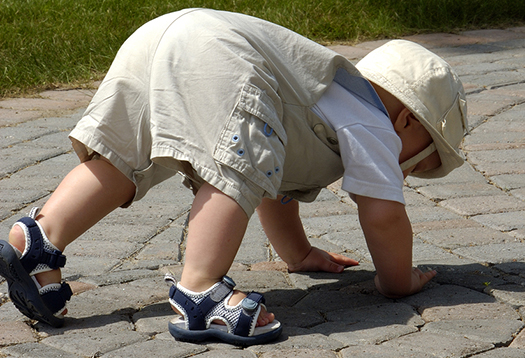Growth and Development for My Baby with Blindness or Low Vision
This content is also available in:
Español (Spanish)

Infants and toddlers grow so quickly and learn so many things. In the beginning, if they are not sleeping, they’re eating or needing a diaper change. Believe it or not, there are things you can do with your infant to help them learn. Your child may need a little extra help learning things. Your child may need longer than other children their age however, they will get there with your help.
Children who are blind or low vision are as unique and as varied as any other group of children. One overall statement, however, does apply to most children who are blind or low vision: a child who is blind or low vision will typically learn about the world differently from a child without a visual impairment.
Depending on individual circumstances, a child:
- May not be able to rely on sight to obtain information, and may, therefore, need to use senses other than vision to acquire information.
- Your child will need particular kinds of attention and extra experiences from infancy on to learn skills that sighted children develop as a matter of course by watching people and objects around them and imitating what they see.
- Typically will need to have clear explanations provided for your child, sometimes repeatedly.
- Direct experiences set up in order to learn what sighted children learn by looking. For example:
- Your child may need to be able to pet the neighbor’s dog from head to tail and to spend time touching the dog’s entire body in order to understand the animal referred to in a story as “a dog” and to determine what a dog really is. In fact, your child may need to touch a number of different dogs over time to really understand what a dog is and to learn that there are several kinds of dogs.
- Your child may need to help stir the batter for a batch of cookies and help put them in the oven. Let them know that the good smell coming from the kitchen is the cookies baking. Finally, enjoying the tasty cookies. Intentionally communicating the process will make the connections between the process of baking and the food they eat.
Because limited vision can have a strong impact on your child’s ability to understand concepts, learn language, move about freely with confidence, and develop and grow in a variety of ways, you and your child’s teachers will need to use alternate methods and strategies for teaching your child basic concepts and the meanings of words now and how to read, write, interact socially, and perform various daily activities as she grows. Teachers of students with visual impairments are experts in using these methods.
What You Can Do
In addition to seeing if your child is eligible for early intervention services and working with a teacher of students with visual impairments, you can help your child grow and develop by remembering that they can learn almost anything that anyone else learns—but may have to learn it differently. Try to keep the following principles in mind.
Give your child explanations and descriptions and ask questions!
Don’t assume your child has learned something just because they have been exposed to it. Your child may need to be specifically taught what a sighted child learns by observing what goes on around her.
Remember that your child may only be obtaining small pieces of information.
Sighted children learn by looking at the whole picture before exploring the parts. Many children with blindness or low vision experience the world the other way around. Your child may have to rely on what they can touch, feel, or hear, and in doing so, may be getting unconnected pieces of information. You can help put these pieces together to form a full concept by providing extra explanations and giving a chance to feel things and explore.
Help your child put it all together.
When you go shopping at the mall, you may see a bakery, but your child may instead smell it. You might see the video arcade, but your child might hear it. If you explain and help your child make sense of all the simultaneous information they may be receiving, you can help increase the understanding of the world.
Provide direct experiences.
Children who are blind or low vision need to have direct experiences in order to learn what sighted children learn by looking. For example, your child might not know that blocks can be stacked on top of each other until you or an older sibling show how to stack.
Give time to explore.
It may take longer for your child to do everyday tasks than other children who are sighted. Give the time needed to explore and to complete things on their own.
Build on other experiences.
If possible, remind your child about a previous experience when telling about something new. This can help make new information clearer and can help reinforce it in their mind. For example, “This dog’s coat is straight and smooth—it is a Labrador retriever. Remember the dog with curly fur we met yesterday? He was a poodle.”
Don’t fall into the habit of “doing.”
Your child has to process so much information, it may be tempting to do things for them because it’s quicker. It’s also tempting for your child to let you do things for them. But it’s not really helpful in the long run. Let your child do things for themselves. They will learn to do and feel good about themselves because they have learned.
Additional Support for Your Developing Child